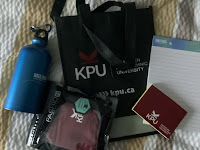My second Friday liveblog is actually the first session I attended today at the WILU conference. Katie Greer (Fine and Performing Arts Librarian, Oakland University) presented on Changing hearts, changing minds: Affect, conspiracy ideation, and strategies for moving forward. As usual, a warning that this is my impression of this rich presentation. Also, I was dropped from the wifi 12 minutes into it, which was distracting and why this is posted a bit later.
Greer started by talking about information disorder and defined mis-information (where no harm is meant); dis-information (false information knowingly shared) and mal-information (genuine info shared to cause harm: such as leaks, harassment and hate speech): see this framework. Because people are contextually situated, the way in which they interpret and react to the information is different.
A second model Greer presented was a two-component socio-epistemic model of belief in conspiracy theories (an updated version of the model in this article). The 2 components are mistrust and misinformation, with numerous factors affecting both elements. She went on to talk about affect, and how we react emotionally before evaluating. Greer talked about the "bloom space", all the emotional and physical factors influencing us at any given time.
Greer identified theoretical underpinnings. [I think from Silvan Tomkins] there is the way in which even if something threatened doesn't happen, it still leaves us with a negative affective state and doesn't convince us that it won't be a threat in the future. Social media is perfectly designed to trigger strong positive and negative emotions through the images etc. Greer showed a couple of images that could raise strong emotions (plus one of small furry animals).
Greer encouraged us to think about the affective states of learners, and how we could consider those in instructional design. Learners' affective states are influenced by bodily/phyiscal and socioeconomic factors, as well as what is happening in their lives. She mentioned Annemaree Lloyd, Mackey & Jacobson (and their metaliteracy model), Nel Noddings and Troy Swanson as writing about affect and information literacy. The metaliteracy model acknowledges the metaliterate learner as affective as well as cognitive, and also foregrounds the social and collaborative role.
Greer also highlighted the SIFT model (Stop, Investigate the source, Find better coverage, Trace claims quotes and media to the original context). In particular she emphasised the importance of the "Stop" part, which includes examining our own emotions. She also mentioned the DIG framework. Greer urged us to consider the strong impact of visuals, which may sensationalise messages more than the text does. She gave an example of a news story about a fire being accompanied by a photo of a completely different massive fire: but the immediate assumption would be it was of the fire mentioned in the text.
Greer advised structuring critical discussions with learners, using resources live Allsides.com and Opposing Viewpoints if you have access to them.
Greer gave the link to a bibliography on Patrons and Conspiracies https://www.zotero.org/groups/4470914/patrons_and_conspiracies
Photo by Sheila Webber: the WILU conference freebies
Curating information literacy stories from around the world since 2005 - - - Stories identified, chosen and written by humans!
Pages
▼

No comments:
Post a Comment